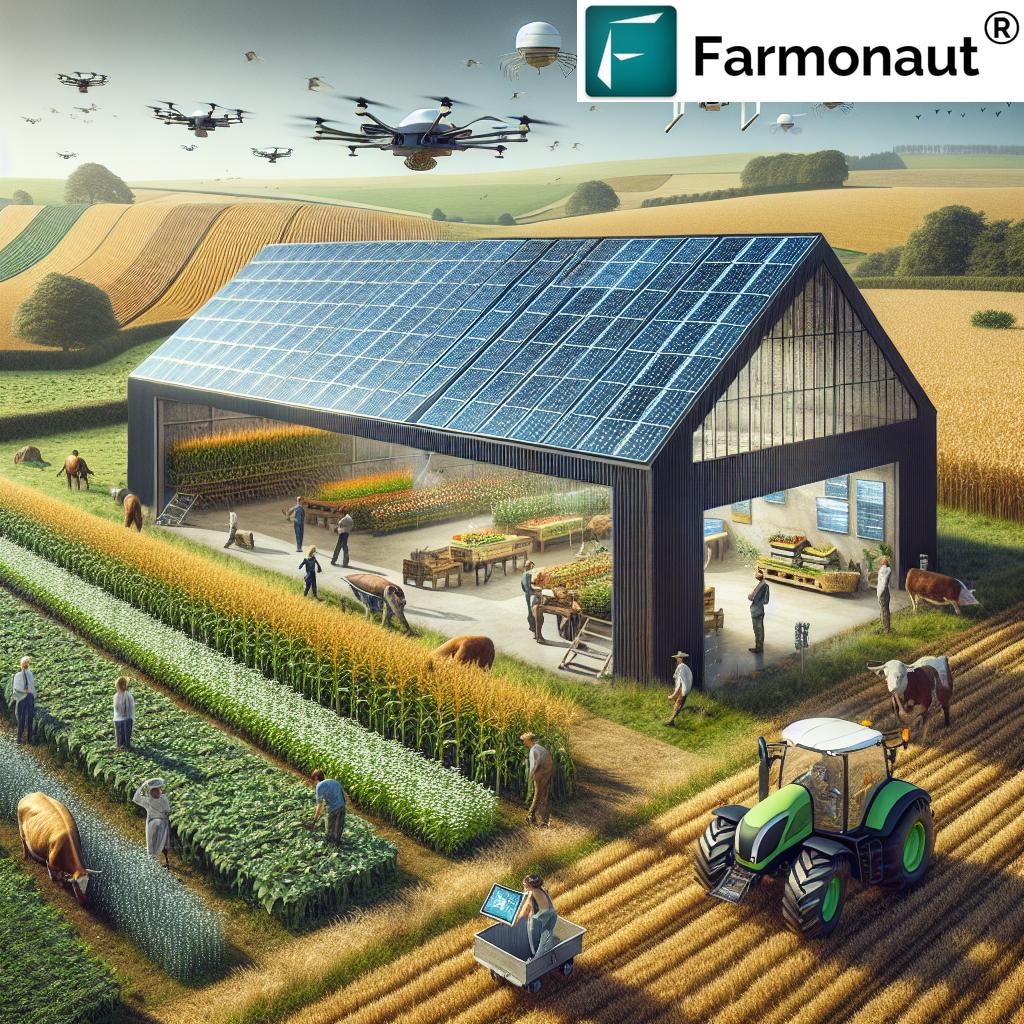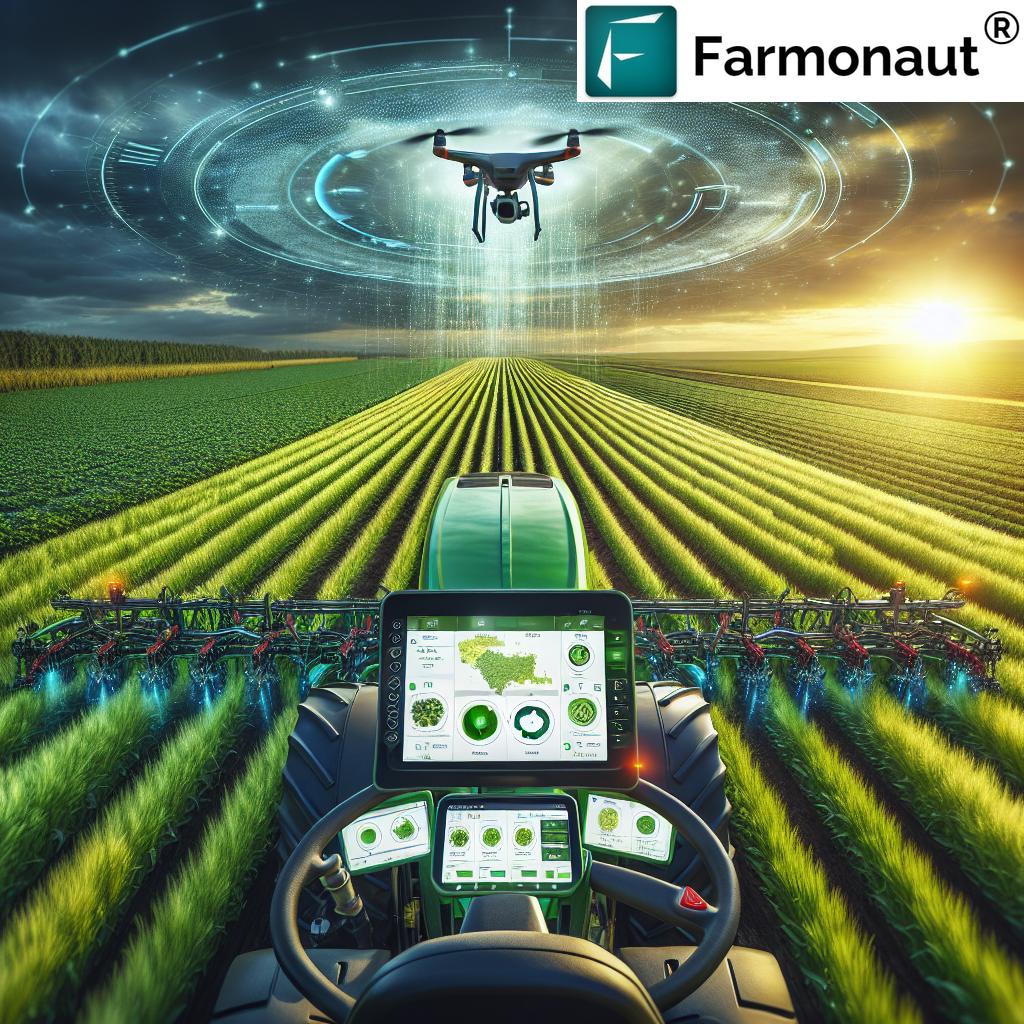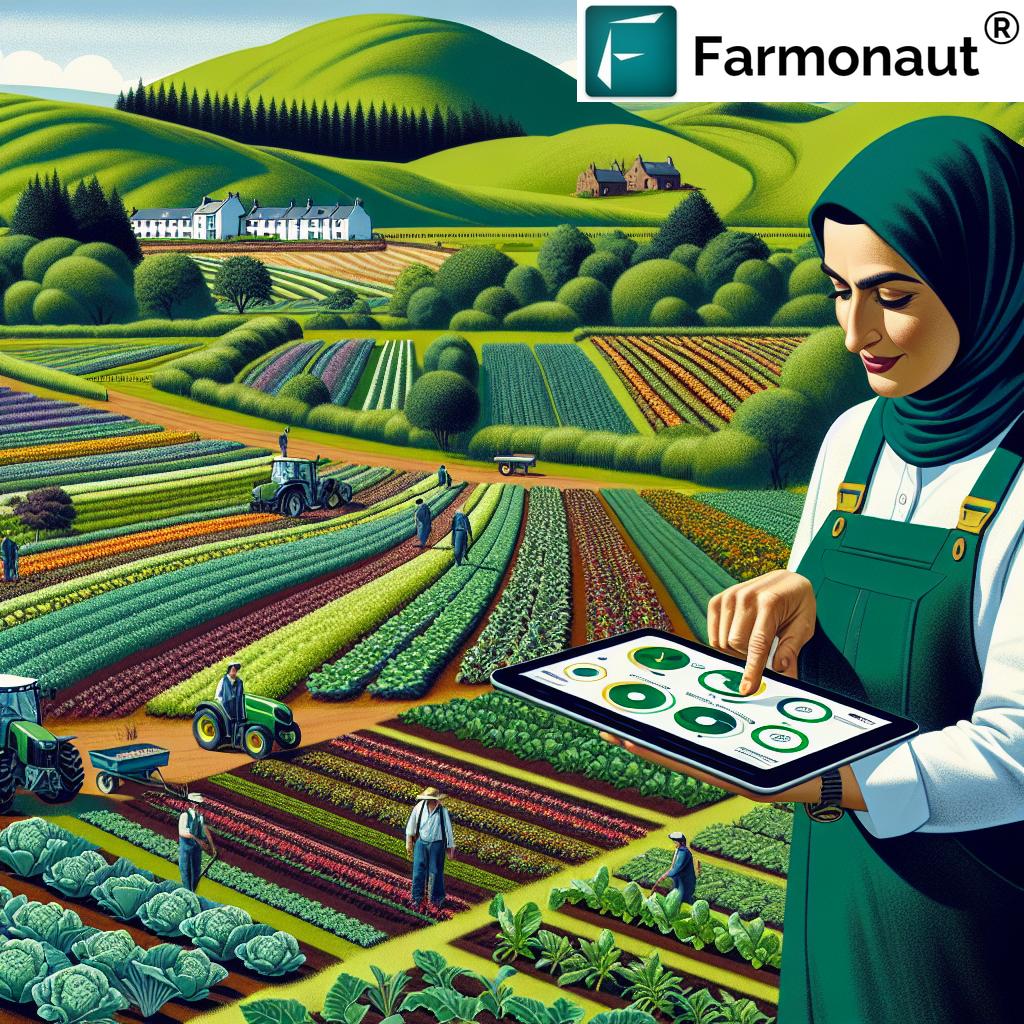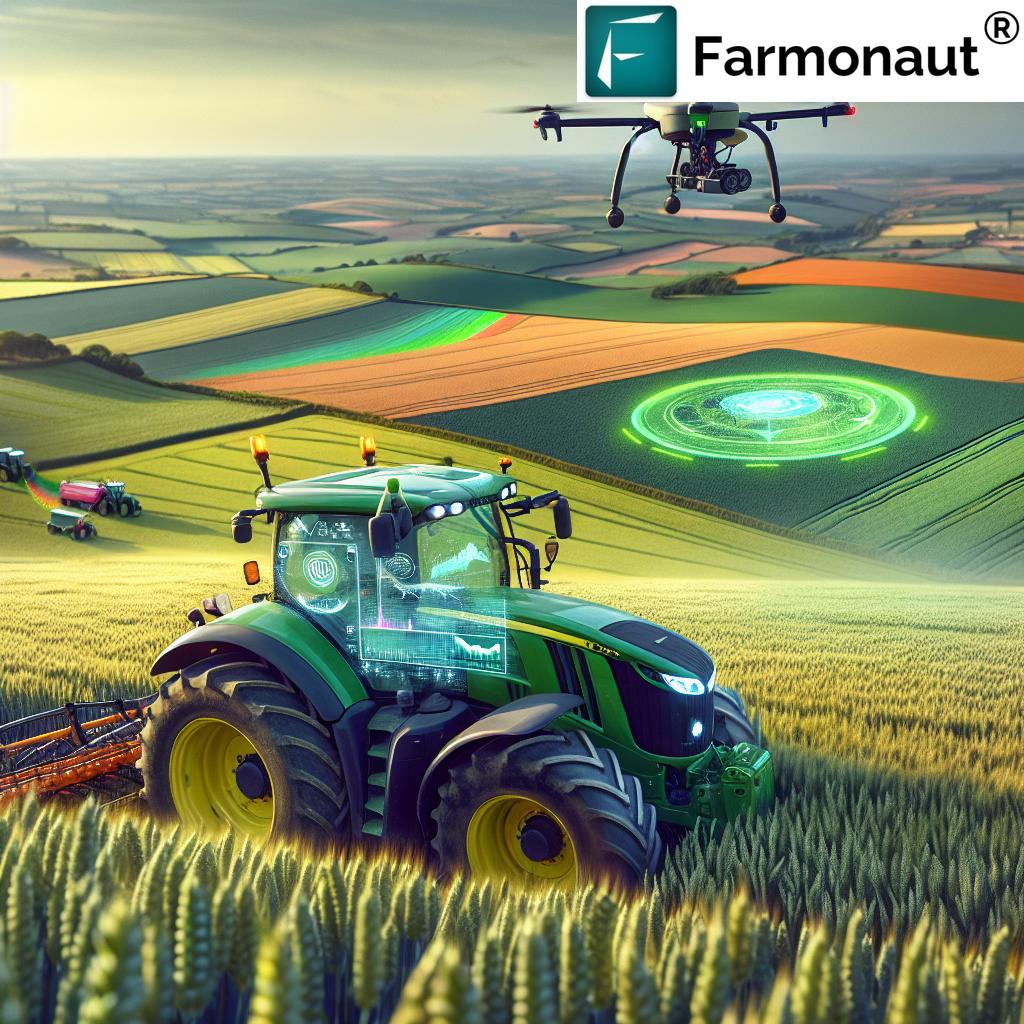Revolutionizing English Farms: Compact Telehandler Boosts Agricultural Efficiency and Versatility
“Compact telehandlers can increase farm operational efficiency by up to 30% in tight spaces.”
Welcome to our comprehensive review of the latest innovation in compact farm machinery – a groundbreaking agricultural telehandler that’s transforming farming operations across England, Scotland, and Wales. At Farmonaut, we’re committed to bringing you the most up-to-date information on agricultural technology and innovations that can enhance your farming practices.
The Dawn of a New Era in Farm Equipment
In the ever-evolving world of agriculture, staying ahead of the curve is crucial for farmers and agricultural businesses. Today, we’re excited to introduce you to a compact telehandler that’s revolutionizing the way we approach farm work. This versatile piece of equipment is designed to meet the diverse needs of modern farming, from livestock management to arable farming, and everything in between.
As we delve into the specifics of this remarkable machine, we’ll explore how it’s reshaping the agricultural landscape across the United Kingdom. Whether you’re a small-scale farmer in the rolling hills of Wales, a large dairy operation in Scotland, or managing extensive arable land in England, this compact telehandler offers solutions to streamline your daily activities and boost productivity.
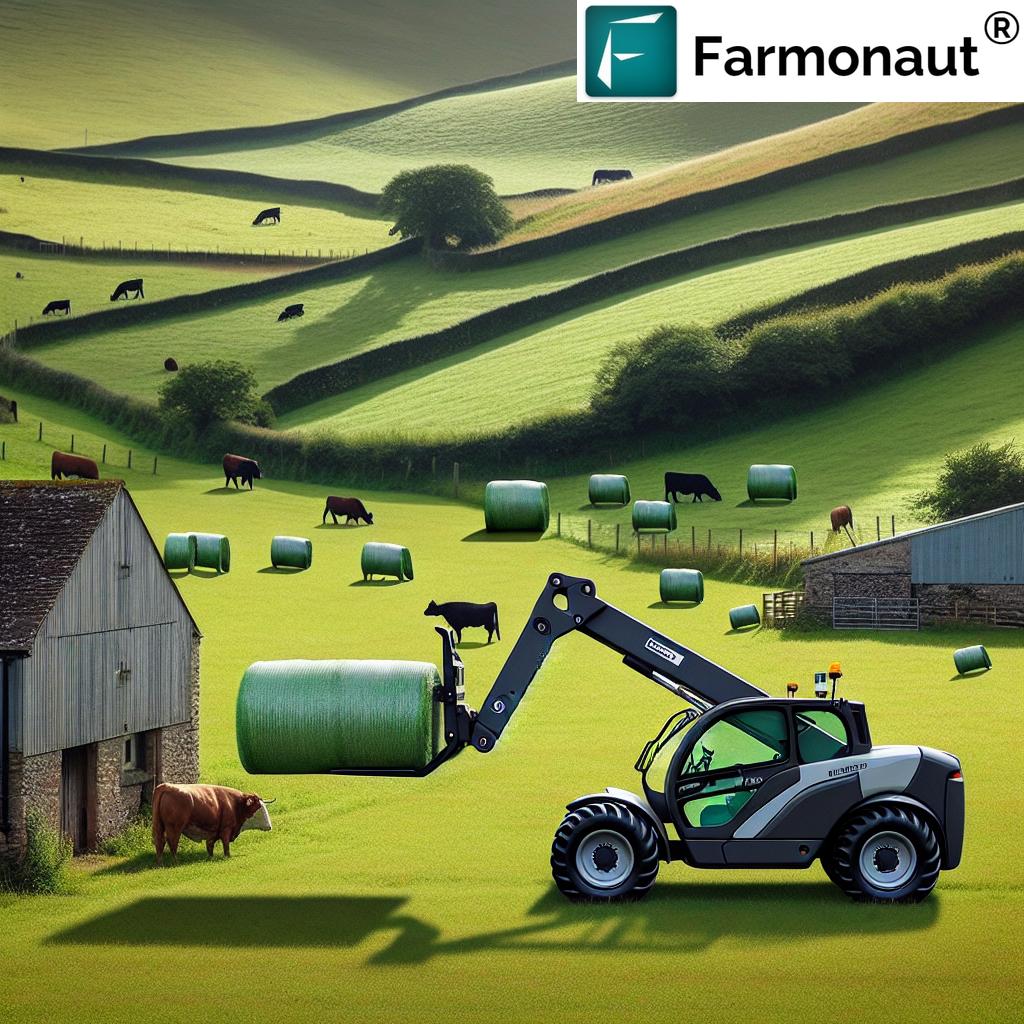
Understanding the Compact Telehandler
Before we dive into the specific features and benefits of this innovative farm equipment, let’s clarify what exactly a compact telehandler is and why it’s causing such a stir in the agricultural community.
- Definition: A compact telehandler is a versatile piece of machinery that combines the lifting capabilities of a forklift with the reach of a crane, all in a compact, maneuverable package.
- Purpose: It’s designed to handle a wide range of tasks on the farm, from moving hay bales and feed to loading trailers and assisting with building maintenance.
- Advantage: The compact design allows for superior maneuverability in tight spaces, making it ideal for farms with limited room or older buildings with narrow entrances.
Now that we have a basic understanding, let’s explore the specific features that make this compact telehandler a game-changer for British farmers.
Key Features and Specifications
The compact telehandler we’re reviewing today is packed with features designed to enhance farm operational efficiency and versatility. Here’s a detailed look at what sets this machine apart:
- Lifting Capacity: Despite its compact size, this telehandler boasts an impressive lifting capacity of up to 3-4 tonnes, making it suitable for a wide range of farm tasks.
- Reach: With an extendable boom, it can reach heights of up to 7 meters, allowing for easy loading of high-sided trailers or stacking of hay bales.
- Maneuverability: The compact design and tight turning radius make it ideal for navigating narrow barn aisles or crowded farmyards.
- Versatility: Multiple attachment options allow for quick switching between tasks, from bucket work to pallet forks.
- Comfort and Ergonomics: The cab is designed with the operator in mind, featuring excellent visibility, intuitive controls, and a comfortable seating position to reduce fatigue during long work days.
These features combine to create a machine that’s not just powerful and versatile, but also comfortable and easy to use, making it an invaluable asset for any farm operation.
Comparing Compact Telehandlers to Traditional Farm Equipment
To truly appreciate the impact of this compact telehandler, it’s helpful to compare it to traditional farm equipment. The following table illustrates key differences:
| Feature | Compact Telehandler | Traditional Farm Equipment |
|---|---|---|
| Maneuverability | High | Moderate |
| Lifting Capacity | 3-4 tonnes | 2-3 tonnes |
| Versatility | 8-10 tasks | 3-5 tasks |
| Fuel Efficiency | 15-20% better | Standard |
| Ease of Operation | User-friendly controls | Varies |
As we can see, the compact telehandler offers significant advantages in key areas, particularly in terms of maneuverability, versatility, and efficiency.
Applications in Various Farming Sectors
“Modern agricultural telehandlers can adapt to over 20 diverse farming applications, from livestock to arable tasks.”
One of the most impressive aspects of this compact telehandler is its adaptability to various farming sectors. Let’s explore how it can benefit different types of agricultural operations:
Livestock Farming
- Feed Management: Easily move and distribute feed, saving time and reducing physical strain.
- Bedding Distribution: Quickly spread bedding material in barns and stables.
- Manure Handling: Efficiently clean out barns and load manure spreaders.
Arable Farming
- Seed and Fertilizer Handling: Load planters and spreaders with ease.
- Harvest Management: Assist with grain handling and storage tasks.
- Equipment Maintenance: Lift and move heavy machinery parts for repairs.
Dairy Farming
- Silage Management: Stack and retrieve silage from bunkers or pits.
- Milk Tank Maintenance: Safely lift and position cleaning equipment for bulk tanks.
- Calf Rearing: Move calf hutches and handle feed for youngstock.
These applications demonstrate the incredible versatility of the compact telehandler, making it a valuable investment for farms of all types and sizes.
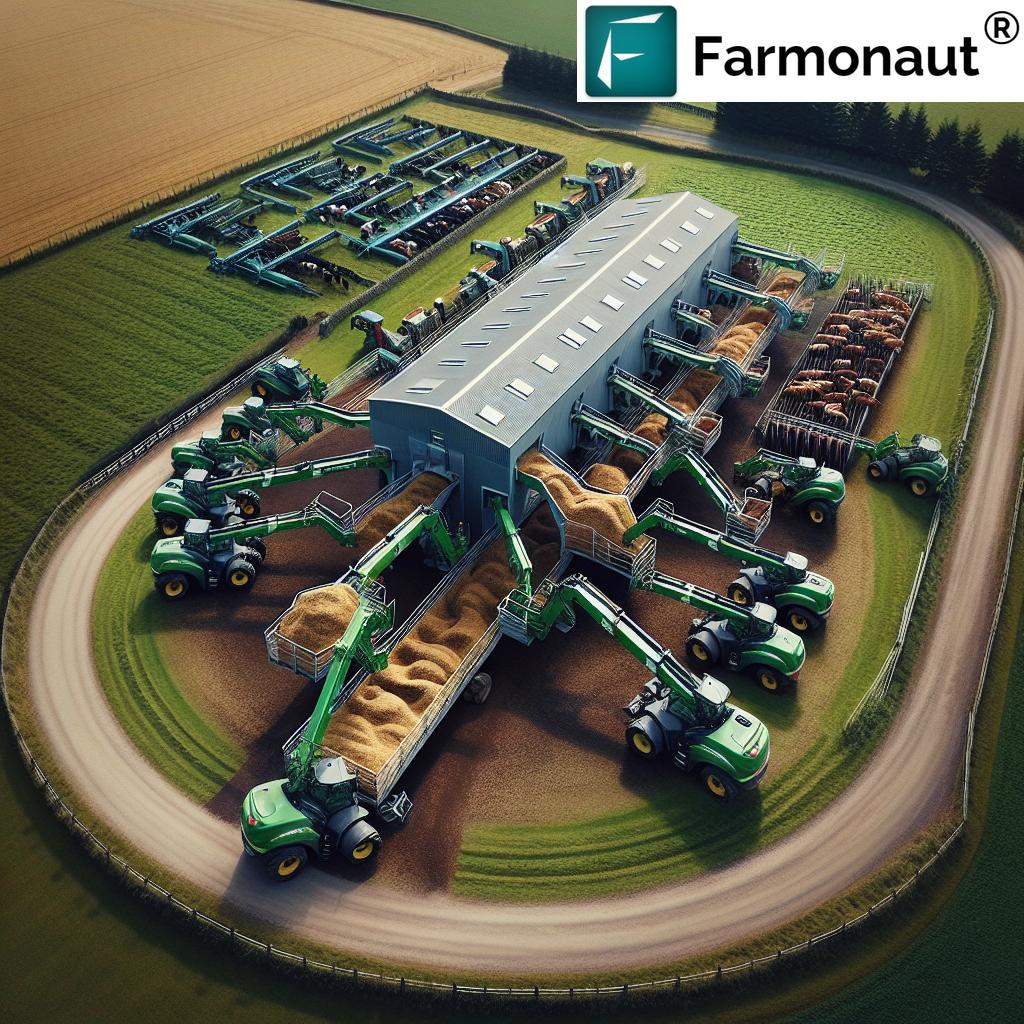
Enhancing Farm Operational Efficiency
The introduction of a compact telehandler can significantly improve farm operational efficiency in several ways:
- Time Savings: The versatility of the machine means fewer equipment changes, reducing downtime between tasks.
- Labor Reduction: One operator can handle tasks that previously required multiple workers, freeing up labor for other important farm activities.
- Improved Safety: The telehandler’s design and controls make it safer to handle heavy loads, reducing the risk of injuries on the farm.
- Fuel Efficiency: Compared to using multiple machines for different tasks, a single efficient telehandler can lead to significant fuel savings.
- Reduced Wear and Tear: By replacing multiple pieces of equipment, there’s less overall machinery to maintain, potentially lowering repair and replacement costs.
These efficiency gains can translate into significant cost savings and productivity improvements for farms across England, Scotland, and Wales.
Adapting to Modern Farming Challenges
As the agricultural landscape evolves, farmers face new challenges that require innovative solutions. The compact telehandler addresses several of these modern farming challenges:
- Labor Shortages: With its versatility and ease of use, the telehandler helps farms operate efficiently with fewer workers.
- Sustainability Pressures: Improved fuel efficiency and the ability to streamline operations contribute to a reduced environmental footprint.
- Economic Pressures: By increasing efficiency and reducing operational costs, the telehandler helps farms remain competitive in a challenging economic environment.
- Diversification: As more farms look to diversify their operations, the telehandler’s adaptability supports a wide range of new ventures, from agritourism to on-farm processing.
By addressing these challenges, the compact telehandler is proving to be an essential tool for forward-thinking farmers looking to future-proof their operations.
User Experience and Ergonomics
The success of any piece of farm equipment ultimately depends on how well it serves the operator. This compact telehandler excels in user experience and ergonomics:
- Intuitive Controls: The control layout is designed for ease of use, with clear labeling and logical placement.
- Visibility: Large windows and a carefully designed cab structure provide excellent visibility in all directions, crucial for safe operation.
- Comfort: Air-suspended seats, climate control, and reduced cabin noise levels ensure operator comfort even during long work days.
- Accessibility: Easy entry and exit from the cab, along with well-placed handholds and steps, improve safety and reduce operator fatigue.
- Customization: Adjustable steering columns and seat positions allow operators to find their ideal working posture.
These ergonomic features not only improve operator comfort but also contribute to increased productivity and reduced risk of operator error or fatigue-related accidents.
Technology Integration
In keeping with the trend towards smart farming, this compact telehandler incorporates several technological advancements:
- Telematics: Built-in systems allow for remote monitoring of machine performance, fuel usage, and maintenance needs.
- Precision Load Management: Advanced sensors and on-board computers help operators handle loads more precisely and safely.
- Eco Modes: Intelligent engine management systems optimize fuel consumption based on the task at hand.
- Connectivity: Some models offer integration with farm management software, allowing for better tracking of equipment use and task completion.
These technological features align well with the growing trend of precision agriculture, helping farmers make data-driven decisions to optimize their operations.
Economic Considerations
Investing in a compact telehandler is a significant decision for any farm. Here are some economic factors to consider:
- Initial Cost: While the upfront investment may be higher than some traditional farm equipment, the versatility often provides better value over time.
- Operational Costs: Improved fuel efficiency and reduced labor needs can lead to significant ongoing savings.
- Maintenance: Regular maintenance is crucial, but the consolidation of tasks into one machine can reduce overall maintenance costs compared to maintaining multiple specialized machines.
- Resale Value: The high demand for versatile farm equipment often translates to strong resale values for well-maintained telehandlers.
- Financing Options: Many manufacturers offer flexible financing solutions to help farmers manage the initial investment.
When evaluating the economic impact, it’s important to consider not just the purchase price, but the total cost of ownership and the potential for increased farm productivity.
Environmental Impact
As sustainability becomes increasingly important in agriculture, it’s worth considering the environmental impact of this compact telehandler:
- Fuel Efficiency: Modern engine designs and eco modes contribute to reduced fuel consumption and lower emissions.
- Reduced Soil Compaction: The compact design and specialized tires help minimize soil compaction compared to larger, heavier machinery.
- Precision Application: When used for tasks like fertilizer spreading, the telehandler’s precision can help reduce overuse of inputs, benefiting both the environment and the farm’s bottom line.
- Longevity: The durability and versatility of these machines mean they can remain in service for many years, reducing the environmental impact of manufacturing and disposing of multiple pieces of equipment.
By choosing efficient, versatile equipment like this compact telehandler, farmers can take meaningful steps towards more sustainable agricultural practices.
Training and Skill Development
To maximize the benefits of a compact telehandler, proper training is essential. Here are some key points regarding operator training:
- Safety First: Comprehensive safety training is crucial, covering topics like load management, stability, and operating in various weather conditions.
- Hands-On Experience: Practical, hands-on training sessions are invaluable for operators to become proficient with the controls and capabilities of the telehandler.
- Ongoing Education: Regular refresher courses and updates on new features or attachments can help ensure continued safe and efficient operation.
- Certification: Many regions require specific certifications for telehandler operators, which can enhance farm safety and potentially reduce insurance costs.
Investing in proper training not only improves safety but also ensures that farms can fully leverage the capabilities of their compact telehandler.
The Future of Farm Equipment
As we look to the future of farming, compact telehandlers like the one we’ve reviewed today are likely to play an increasingly important role. Here are some trends we anticipate:
- Increased Automation: Future models may incorporate more autonomous features, potentially leading to self-driving capabilities for routine tasks.
- Enhanced Connectivity: Greater integration with farm management systems and IoT devices will provide even more data-driven insights.
- Alternative Fuel Sources: As the push for sustainability continues, we may see more electric or hydrogen-powered telehandlers entering the market.
- Advanced Materials: The use of lighter, stronger materials could further enhance the lifting capacity and fuel efficiency of these machines.
By staying at the forefront of these technological advancements, farmers can ensure their operations remain competitive and efficient in the years to come.
Conclusion
The compact telehandler we’ve explored today represents a significant leap forward in farm equipment technology. Its combination of versatility, efficiency, and user-friendly design makes it an invaluable tool for modern farms across England, Scotland, and Wales.
From improving operational efficiency and addressing labor shortages to supporting sustainable farming practices, this innovative machine is helping farmers meet the challenges of 21st-century agriculture. As farms continue to evolve and diversify, equipment like this compact telehandler will play a crucial role in maintaining productivity and profitability.
We encourage farmers to consider how a compact telehandler might fit into their operations, potentially streamlining tasks, reducing costs, and opening up new possibilities for farm management. As always, careful consideration of your specific needs, thorough research, and proper training are key to making the most of any new farm equipment investment.
FAQs
- Q: How does a compact telehandler differ from a standard telehandler?
A: Compact telehandlers are smaller and more maneuverable, making them ideal for working in tight spaces on farms. They typically have a lower lifting capacity but offer greater versatility in confined areas. - Q: Can a compact telehandler replace my tractor for most tasks?
A: While a compact telehandler is highly versatile, it’s not designed to replace a tractor entirely. It excels in material handling tasks but may not be suitable for heavy field work like plowing or large-scale crop spraying. - Q: What kind of maintenance does a compact telehandler require?
A: Regular maintenance typically includes oil and filter changes, hydraulic system checks, and tire maintenance. It’s important to follow the manufacturer’s recommended service schedule to ensure optimal performance and longevity. - Q: Are there any specific safety considerations when using a compact telehandler?
A: Key safety considerations include understanding load charts, maintaining proper tire pressure, being aware of overhead obstacles, and ensuring the machine is on stable ground when lifting. Proper training is essential for safe operation. - Q: How does the cost of a compact telehandler compare to other farm equipment?
A: While the initial cost may be higher than some specialized equipment, the versatility of a compact telehandler often provides better overall value. It’s important to consider the total cost of ownership, including fuel efficiency and maintenance costs.
For more information on how technology is transforming agriculture, visit Farmonaut’s web app or check out our mobile apps:
For developers interested in integrating agricultural data into their own applications, explore our API and API Developer Docs.





